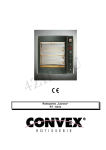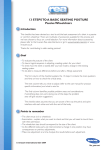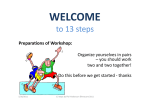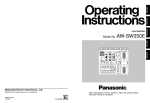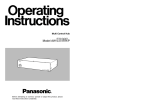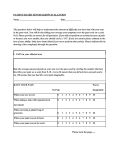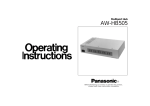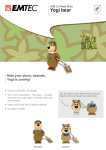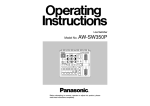Download User's Guide Pelvic Positioning (Page 1 - 2)
Transcript
Hip Belt Specifications ANGLES OF ATTACHMENT The angle that the hip belt is attached to the wheelchair has a direct effect on the angle of pull on the pelvis. 60° 45° 0° is not possible, measure from ASIS to ASIS and add a couple of inches. The correct belt size for the individual has padding that covers all of the bony prominences. Considerations: • A 60° angle of attachment to the seat rail positions the hip belt anterior and inferior to the ASIS, which reduces the tendency of the client with a posterior pelvic tilt to slip underneath the belt. • A higher angle of attachment on the back post encourages a posterior pelvic tilt, which assists in positioning clients with an anterior pelvic tilt. • The secondary straps of a 4-point hip belt are attached to the seat post between 45° and 90° to hold the primary padded strap in place and to prevent the belt from riding into the abdomen or twisting. • The angle of attachment may have to be compromised in order to accommodate such situations as wounds in the pelvic area, unstable hip joints or gastric tubes. XS 5"–9" (13cm–23cm) S 7"–11" (18cm–28cm) M 9"–15" (23cm–38cm) L 13"–19" (33cm–48cm) Hip Belt User’s Guide The pelvis is the key to postural alignment as it dictates the position of the trunk, head and extremities. ATTACHING TO THE FRAME The Cinch-Mount end-fittings provide a quick and easy method for achieving precise adjustments when fitting the belt to the wheelchair. Used in conjunction with the FrameSaver Clamp, a wide variety of suitable mounting locations can be created. Proper mounting can also extend the life of the belt and improve its pressure distribution. Mount the belt to the wheelchair frame as close to the pelvis as possible. Consider interference with any other devices and wheelchair mechanics. Install in 3 Easy Steps: TIGHTENING THE BELT Keep belt tightened at adjustment straps during fitting and daily use to ensure correct pad placement. For padded hip belts the pads are to be touching when correctly tightened. For non-padded hip belts the adjustment strap at the buckle should be approximately 3" (76 mm) long. Education of the caregiver is essential for correct hip belt positioning. Bodypoint Hip Belts are designed for positioning, not as a safety restraint for transport. Do not mistake a positioning-belt with a "seat-belt.” The requirements of a belt used for postural support are very different from the requirements of a belt used for transportation safety. SIZING Measure hip width to determine the belt size required. The suggested method for measuring hip width is from trochanter to trochanter. If this Every client is unique and individual, as is every positioning problem. There is no “correct” solution to a specific problem. Keeping in mind that the least amount of intervention is preferable. Adaptive equipment that limits a client’s active movement must be monitored continuously. 1 Pull Styles 2 3 Two vs. Four Point REAL-PULL HIP BELT Operator: Caregiver Adjustment: Tightens in the direction from the rear of the pad to the center, with a pulley-like mechanism. Buckles: Side-release, metal push button and compact buckles. Applications: Clients with high tone. Allows the caregiver to position one side of the pelvis, lock it in place and then position the other side. Two-Point Hip Belt: The belt has two points of attachment to the wheelchair. Suitable when the belt is addressing low tone or weakness. CENTER-PULL HIP BELT Operator: User or caregiver Four-Point Hip Belt: The belt has four points of attachment to the wheelchair. Primary attachments position the belt like two-point hip belt and secondary attachments anchor the belt in position to prevent it from riding up into the abdomen or twisting. Holds the pelvis much more aggressively for situations when the person has a lot of movement. Adjustment: Tightens away from the center. Buckles: Available with full buckle range. Applications: Clients with low muscle tone or weakness. DUAL-PULL HIP BELT Operator: User or caregiver Adjustment: Tightens from both sides of the buckle away from the center. Buckles: Side-release buckle only. Applications: Clients who require greater adjustment range to accommodate clothing and weight changes. 800.547.5716 | BODYPOINT.COM Warranty: All Bodypoint products carry an unconditional guarantee against defects in workmanship and materials. Items found to be defective will be repaired or replaced at the discretion of Bodypoint. IDEAL POSTURE: • Neutral alignment of spine and head • Level pelvis • Shoulders slightly posterior to pelvis PRIMARY SUPPORT SURFACES CONSIDERATIONS: • Fitted to the individual • Solid seat and back • Correct back height depends on the amount of trunk support needed • Seat depth allows 1" (25mm) from back of knee to front of seat • Seat width allows 1⁄2" (13mm) on either side • Correct use of lateral supports • Correct armrest height allows for 30° shoulder flexion and 60° elbow flexion • Footplate position allows 2" (51mm) clearance from floor and femurs to be parallel to seat • Stable cushion • Achieve balance between support and function Good posture is the result of balancing the skeleton in relation to gravity. The long-term goals for a good posture are to increase function of the individual, provide pressure relief and reduce demands on muscles. There are three points for pelvic stabilization: the seat, the back and an anterior support. A.S.I.S. Anterior Superior Iliac Spine. Key orientation point to assess pelvic position and to determine belt placement. Ideal Posture: Hips: 100° Knees: 105° Ankles: 90° R E C O M M E N D A T I O N S F O R T R E A Posterior Pelvic Tilt T M E N T O F P O S I T I O N I N G T E N D E N C I E Anterior Pelvic Tilt ASSESSMENT • Sacral sitting - most common tendency • ASIS higher than PSIS (Posterior Superior Iliac Spine) • Tends to slide out of chair • Flexed lumbar spine • Thoracic kyphosis • Shoulders protracted • Increased cervical extension • ‘C’ type posture ASSESSMENT • ASIS lower than PSIS (Posterior Superior Iliac Spine) • Thoracic kyphosis is reduced or reversed • Increased lumbar lordosis • Shoulders retracted • Trunk extension CAUSES Wheelchair issues: such as seat depth too long, back support too short, and footplates too low. Physical conditions: such as tight hamstrings, muscle weakness, and kyphosis. ATTACHMENT Position the padded belt anterior and inferior to the ASIS and attach at a 60° angle to the seat posts. (See back page for Hip Belt options and Angles of Attachment). CAUSES Wheelchair issues – such as seat to back angle too small. Physical conditions – such as tight hip flexors, weak abdomen muscles, and lordosis. Uncorrected posture. Improved positioning with Hip Belt (HB104) shown. HIP BELT OPTIONS The objective of the belt is to prevent sliding. HB202 Two-Point Dual-Pull ATTACHMENT Position the padded belt over the ASIS and attach at 90° to the wheelchair back posts. Anchor the secondary straps to the seat posts between 45° and 90°. (See back page for Hip Belt options and Angles of Attachment). HB104 Two-Point Center-Pull Uncorrected posture. Improved positioning with Hip Belt (HB505) shown. HIP BELT OPTIONS The objective of the belt is to resist forward tilt of the pelvis. HB505 Four-Point Dual-Pull HB512 Four-Point Rear-Pull Pelvic Rotation Pelvic Obliquity ASSESSMENT • One ASIS is higher than the other – obliquity refers to the lower side • Compensatory C-shaped curve in the lumbar and thoracic spine • Lateral tendency • Shoulder on the side of the obliquity tends to be elevated • Usually involves rotation CAUSES Wheelchair issues: such as sling back/seat upholstery, wheelchair too wide, and seat too short. Physical conditions: such as irregular trunk muscle tone, muscle imbalance, and scoliosis. ASSESSMENT • One ASIS is more forward than the other • One hip abducted and one hip adducted • Appears to have leg length discrepancy or a ‘wind-swept’ appearance CAUSES Wheelchair issues: such as seat depth too short or too wide. Physical conditions: such as seat depth too short or too wide. Uncorrected posture. ATTACHMENT Position the padded belt over the ASIS and attach at 60° to the wheelchair back posts. When using a Four-Point Hip Belt, anchor the secondary straps to the seat posts between 45° and 90°. (See back page for Hip Belt options and Angles of Attachment). Improved positioning with Hip Belt (HB402) shown. HIP BELT OPTIONS: The objective of the belt is to bring the pelvis down and back into the seating system. HB402 Two-Point Rear-Pull ATTACHMENT Position the padded belt over ASIS and attach at 90° to the wheelchair back posts. Anchor the secondary straps to the seat posts between 45° and 90°. (See back page for Hip Belt options and Angles of Attachment). HB512 Four Point Rear-Pull Uncorrected posture. Improved positioning with Hip Belt (HB512) shown. HIP BELT OPTIONS: The objective of the belt is to bring the pelvis back into position and hold it there. HB402 Two-Point Rear-Pull HB512 Four-Point Rear-Pull Buckle Styles Consider the needs of the person operating the belt (user vs. caregiver). Metal Push-button Extra Small Metal Push-button Plastic Push-button Compact Push-button Aircraft Latch Plastic Side Release Very easy release button action Strong, secure, child-sized buckle Low profile and easy to release Firm button action prevents accidental release Easy to operate with limited hand function Lightweight, secure snap action S




